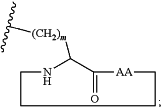| CPC C07H 15/18 (2013.01) [A61P 9/00 (2018.01); C07D 225/08 (2013.01)] | 14 Claims |
|
1. A compound of Formula Ia, or a pharmaceutically acceptable salt thereof, having the structure:
 wherein:
 is a carbon-carbon single or double bond; is a carbon-carbon single or double bond;A is C6-18 aryl, C6-18 heterocyclyl, C6-18 biaryl, or C6-18 heterobiaryl, wherein each of C6-18 aryl, C6-18 heterocyclyl, C6-18 biaryl, and C6-18 heterobiaryl is independently optionally substituted by 1-6 substituents selected from the group consisting of F, Cl, Br, I, O(RG), OC(O)N(RG)2, CN, NO, NO2, ONO2, CF3, OCF3, (RG), N(RG)2, S(RG), SO(RG), SO2(RG), SO2N(RG)2, and SO3(RG);
LA is an asialoglycoprotein receptor (ASGPR) binding moiety with the structure
 LB is an anti-β1AR binding moiety with the structure
 AA is an amino acid sequence at least 80% homologous to SEQ ID NO:1;
each occurrence of RG1′ is independently
 each occurrence of RG1 is independently H or
 each occurrence of ZG is:
 AG is
 RG2 is H;
RG3 is C(═O)CH3;
each occurrence of RG is independently H, unsubstituted or substituted C1-10 alkyl, unsubstituted or substituted C3-10 cycloalkyl, unsubstituted or substituted C6-18 aryl, or unsubstituted or substituted C5-18 heteroaryl;
each occurrence of XG is independently selected from the group consisting of one or more of —CH2—, —C(═O)—, —NH—, and —O—;
m is 2, 3, 4, 5, 6, 7, 8, 9, or 10;
n is 1, 2, 3, 4, 5, 6, 7, 8, 9, 10, 11, 12, 13, 14, 15, 16, 17, 18, 19, or 20; and
p is 1, 2, 3, or 4.
|